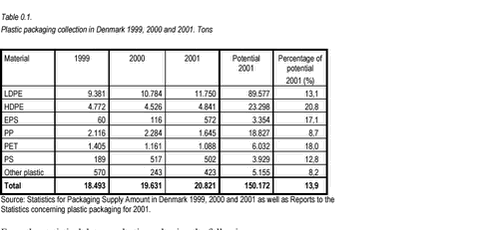| Forside | | Indhold | | Forrige | | Næste |
Plastic Packaging Statistics 2001
Summary
The purpose of these statistics is to illustrate the market development for recycling of plastic packaging waste in 2001.
The study presents the amount of plastic packaging waste collected in Denmark and the amount of plastic packaging consumed in Denmark. The table summarises the results.

Click on the picture to see the html-version of: ‘‘Plastic packaging collection in Denmark 1999, 2000 and 2001. Tons‘‘
Source: Statistics for Packaging Supply Amount in Denmark 1999, 2000 and 2001 as well as Reports to the Statistics concerning plastic packaging for 2001.
From the statistical data on plastic packaging the following appears:
- The amount of plastic packaging waste collected for recycling in Denmark amounted in 2001 was 20,821 tons, equivalent to 3,9 kg per inhabitant or 8.6 kg per household.
- The potential in 2001 is 150,172 tons, equivalent 28.1 kg per inhabitant or 62.0 kg per household.
- The amount of plastic packaging waste collected for recycling in Denmark amounted to 20,821 tons in 2001. The increase in the collection compared to 2000 was 1,190 tons or 6.0 %. The Agreement on Transport Packaging, as well as the municipal assignment schemes for transport packaging has caused a small increase in 2001 in collection for recycling purposes.
- In 2001 13.9 % of the plastic packaging waste in Denmark was collected for recycling. In 2000 the figure was 125 %.
- PE made up approx. 75 % of the potential and approx. 80 % of the collected amounts. These figures are almost unchanged compared to 2000.
- The export of plastic packaging rose from 2000 to 2001 with 7 % from 42 to 49 % of the total collected amount.
- Approx. 53 % of the plastic packaging reprocessed in Denmark in 2001 was imported from abroad. In 2000 the figure was 51 %.
- In 2001 the capacity of the reprocessing companies to receive plastic packaging was at least 24 % higher than the amounts they currently get. This figure is almost unchanged since 2000.
| Forside | | Indhold | | Forrige | | Næste | | Top |
|
